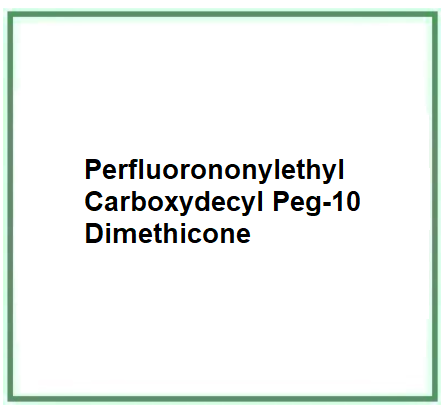Perfluorononylethyl Carboxydecyl Peg-10 Dimethicone is an inorganic chemical compound, a Dimethicone by-product.
The name describes the structure of the molecule:
- Perfluorononylethyl refers to a perfluorinated carbon chain with nine carbon atoms (nonyl) attached to an ethyl group. Perfluorination means that all hydrogen atoms in the carbon chain have been replaced by fluorine atoms.
- Carboxydecyl refers to a decyl group (a chain of ten carbon atoms) with a carboxylic acid functional group (-COOH) at one end.
- PEG-10 PEG stands for polyethylene glycol, which is a polymer of ethylene oxide that I will describe later, and10 indicates the average number of repeated ethylene oxide units in the PEG chain.
- Dimethicone is a type of silicone often used in cosmetics for its ability to form a protective barrier on the skin and to give products a soft feel.
The synthesis process takes place in different steps:
- Silicone production. The basic silicone polymer, dimethicone, is produced through a process called hydrolysis and condensation of dichlorodimethylsilane.
- PEGylation. Dimethicone is modified to include polyethylene glycol (PEG) groups in a process called PEGylation, in which the PEG is attached to the dimethicone using a catalyst.
- Perfluoronyl addition. Pegylated dimethicone is modified to include perfluoronyl groups by a process called fluorination, in which the perfluoronyl groups are attached to the pegylated dimethicone using a catalyst.
- Carboxy group addition. The dimethicone is further modified to include carboxydecyl groups by a process called carboxylation, in which the carboxydecyl groups are attached to the perfluoronyl-modified and pegylated dimethicone using a catalyst.
What it is used for and where
Cosmetics
Skin conditioning agent. It is the mainstay of topical skin treatment by restoring, increasing or improving skin tolerance to external factors, including melanocyte tolerance. The most important function of the conditioning agent is to prevent skin dehydration, but the subject is rather complex and involves emollients and humectants.
Surfactant - Emulsifying agent. Emulsions are thermodynamically unstable and are used to soothe or soften the skin and emulsify, so they need a specific, stabilising ingredient. This ingredient forms a film, lowers the surface tension and makes two immiscible liquids miscible. A very important factor affecting the stability of the emulsion is the amount of the emulsifying agent. Emulsifiers have the property of reducing the oil/water or water/oil interfacial tension, improving the stability of the emulsion and also directly influencing the stability, sensory properties and surface tension of sunscreens by modulating the filmometric performance.
Safety
Dimethicone ((polydimethylsiloxane) is a chemical compound, a high molecular weight polymer derived from silicone, a chemically inert mixture of linear methylated siloxane polymers. The term 'dimeth' denotes two methyl groups bonded to the silicone molecule that provide the formation of dimethicone. It possesses a pronounced viscoelasticity characteristic and is hydrophobic, thus adding shine and slipperiness when applied to hair or skin. It forms a kind of barrier that prevents exogenous substances from entering the stratum corneum and at the same time prevents water loss. It is also UV-resistant, non-greasy and cost-effective. At low concentrations it is considered by the US FDA (Food and Drug Administration) to be a skin protector with a good degree of safety.
It is therefore considered safe when formulated to be non-irritating in cosmetic products as, given its high molecular weight, it is poorly absorbed by the skin or scalp.
And now let us talk about PEGs.
Since the PEG (Polyethylene glycol) family is very numerous and can be found in cosmetic, industrial, pharmaceutical, medical and other products, we need to make an introductory statement on the subject, which is rather complex from a safety point of view because these products not only come into contact with the skin, but, as in the case of medical products, are ingested.
PEGs (polyethylene glycol) polymerise condensed ethylene oxide and water and are referred to as polyethylene glycols, but are actually complex chemical components, polymers bonded together. For example, plastic is polyethylene and has a hard consistency, while polyethylene combined with glycol forms a liquid. PEGylation is produced not only as etherification, but also as transesterification, which is the transformation of an alcohol by an ester.
The number appearing after the abbreviation PEG represents the molecular weight and the higher this number is, the less it penetrates the skin.
The term 'eth' refers to the ethoxylation reaction with ethylene oxide after which residues of ethylene oxide and 1,4-dioxane, chemical compounds considered carcinogenic, may remain. The degree of safety therefore depends on the degree of purity of the compound obtained. No manufacturer appears to provide this information on the label, at least as of the date of this review.
![]() Perfluorononylethyl Carboxydecyl Peg-10 Dimethicone
Perfluorononylethyl Carboxydecyl Peg-10 Dimethicone 

